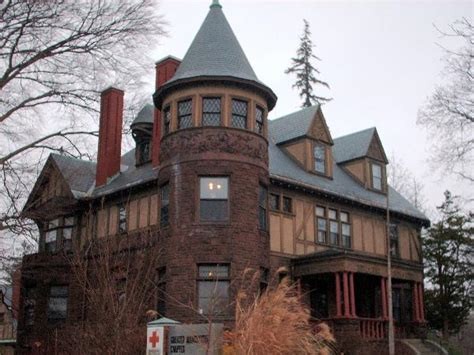Frank Pierce Carpenter House
Introduction
Text-to-speech Audio
Images
Frank Pierce Carpenter House

Backstory and Context
Text-to-speech Audio
The Frank Pierce Carpenter house was constructed in 1891 and believed to be designed by Edgar Allen Poe Newcomb (1846-1924), and Frank Pierce Carpenter owned the house from its construction to his death in 1938. The home is notable due to its embodiment of the Queen Anne architectural style that still retains the integrity of its original location, design materials, and workmanship. The Frank Pierce Carpenter house is a two-and-a-half-story home that embodies this style through its modified square plan and its exemplified use of corner turrets, bay windows, and its three porches. The interior and the exterior of the home feature ornate decorations such as stained glass windows and detailed woodworking. This home is an example of the architectural style that was most prominent among Manchesters' wealthiest residents during the late 1800s.
Frank Pierce Carpenter, born in Chichester, New Hampshire, on October 28, 1845. His father was a well-known citizen of the area, having served in the state legislature. The family moved to Concord, New Hampshire, where Carpenter completed high school. In 1864, Frank Pierce Carpenter moved to Manchester, New Hampshire, where he would become a notable fixture. When Carpenter first arrived in Manchester, he worked as a clerk at a hay and grain business. But soon, he began his own flour and grain business. However, Carpenter dissolved the business in 1885. Carpenter's next venture was the purchase of the Amoskeag paper mill, a prominent company in Manchester, and Carpenter's prominent venture for the remainder of his life.
Carpenter was also involved in several businesses and organizations in Manchester, including working as the director of the Amoskeag National Bank, Amoskeag Trust Company, each of which is a part of the Amoskeag Manufacturing Company. He also worked in some capacity at the New Hampshire Fire Insurance Company, the Concord and Montreal Railroad, among many other businesses and industries. Frank Pierce Carpenter also was interested in the arts and sciences and served on the board of the Currier Gallery (which would become the Currier Museum of Art) and commissioned the creation of the Franklin Pierce statue in 1914. Based on these various ventures, Carpenter was highly involved in his community and did what he could to serve it and make it better.
To conclude, the Frank Pierce Carpenter house located on Elm Street in Manchester is an example of the Queen Anne style of architecture that was popular among the wealthy during the nineteenth century. However, it also serves as a commemoration to Frank Pierce Carpenter, who owned the Amoskeag Mills, and did his best to serve and better his community in a multitude of ways.
Cite This Entry
Lindsey Marquis. "Frank Pierce Carpenter House." Clio: Your Guide to History. April 28, 2021. Accessed April 11, 2025. https://theclio.com/entry/132490
Sources
Hengen, Elizabeth D. "Nomination Form: Frank Pierce Carpenter House", National Register of Historic Places. January 27th, 1994. Accessed April 20th, 2021. https://npgallery.nps.gov/NRHP/GetAsset/NRHP/94000168_text.
“Frank Pierce Carpenter House.”Roadtrippers. Accessed April 26, 2021. https://bit.ly/3eMXZ6X
"Frank Pierce Carpenter", Find A Grave. Accessed April 28th, 2021. https://www.findagrave.com/memorial/42965434/frank-pierce-carpenter.
Metcalf, Harry Harrison. Abbott, Frances Matilda. One Thousand New Hampshire Notables. Concord, New Hampshire. The Rumford Printing Company, 1919.
https://www.waymarking.com/waymarks/WM2QJC_Carpenter_Frank_Pierce_House__Manchester_NH

